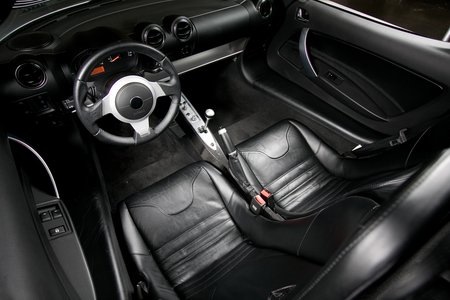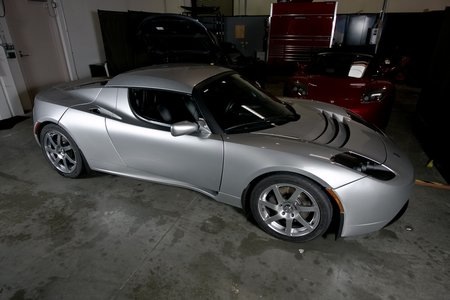Click on the Tesla Roadster for a high-res gallery
Ever since Tesla Motors emerged from its Silicon Valley startup stealth mode in July 2006, the company has been getting a remarkable amount of media attention. Obviously, a lot of chatter came from the automotive media. However, given the people involved, its location and the nature of the car, plenty of outlets who would normally ignore a new car announcement suddenly became obsessed with this aspiring manufacturer. While millions of words have been spilled onto page and screen, until now no one outside the company and only a few customers have been able to speak from first hand knowledge behind the wheel of the Roadster.
Back in November, following the media previews for the Los Angeles Auto Show, I got my first direct exposure to the Roadster when I went for a ride with Tesla Marketing VP Darryl Siry in the canyons around Malibu. Shortly after that the crews from the big print mags got their turn to thrash the Roadster before I finally got the call. As soon as we nailed down a date and time I flew across the country only to be met by overcast skies and intermittent rain on the appointed day. Paraphrasing our friends at USPS, neither rain, nor snow will keep us from bringing you our first driving impression of the Tesla Roadster. It's available after the jump along with a video, and don't forget to check Autoblog's companion review that focuses more on the driving experience as it compares to the Lotus Elise, the car on which the Tesla Roadster is based.
click any image to enlarge


Of course, the natural inclination when you have a car of this type and the heavens are not drenching you is to remove the top. This is actually fairly easy to do with the Tesla Roadster. Release a latch on each side above the windows and roll it up. Then remove the two support ribs in the middle, drop it all in the relatively spacious trunk and you're off. All in all, a much easier process than the contraption that GM tries to pass off as a top on Pontiac Solstice/Saturn Sky. The car we used for the drive was the same VP10 (Validation Prototype 10) that I rode in previously. It has the original XTrac two speed gear-box with first gear locked out allowing it to simulate the behavior that can be expected from the single-speed units that will be used for early production cars starting March 17.

Even though the rain had stopped, the temperature was only about 50F when we left and the roads were still damp. Heading west on some open roads, I started to explore the upper half of the AC induction motor's 13,000 rpm range and found that what I felt from the right seat previously was no fluke. Moving the accelerator toward the floor induced an instant rush of acceleration that just never seemed to let up. In any electrically-driven vehicle, one sure way to appreciate this acceleration capability is to floor it going up hill. Even at 60mph the rush of acceleration while climbing up hill is incredible as you watch the needle rotate insistently to the right.

The two-speed transmission that had been planned would have provided additional torque multiplication in low gear to help achieve the four-second 0-60mph time, with second gear allowing the car to run up 125mph. Without the lower gear, the car takes about 5.7seconds to break the 60mph barrier. The limiting factor that prevents the motor from making more than 248hp continuously is heat dissipation.
Even at 90 percent efficiency, a motor still produces some heat. In this case, the heat is in the rotor. The current motor being used in the Roadster is air-cooled. To prevent damage, when the rotor temperature gets too high the current flow is reduced, limiting power. In the course of doing development on the drivetrain for the WhiteStar sedan project, a more powerful motor was needed for the larger and heavier car. In order to achieve this, the team developed a larger diameter motor with a liquid-cooled rotor.
The video meant to be presented here is no longer available. Sorry for the inconvenience.
This liquid-cooled unit forms the basis of what's being done for Roadster DriveTrain 1.5. The current air-cooled motor will be replaced by a unit the same size with liquid cooling. This will allow it to run at higher sustained power levels without overheating. Upgraded power electronics will feed more juice to the motor when needed for acceleration. A higher torque rated single-speed reduction gear transmission will handle sending power to the rear wheels.
For the moment, though, the Roadster still has DriveTrain 1.0 and that's what I got to exercise. The first thing you notice with the Roadster is relatively heavy steering as you initially pull away. That's because the Roadster inherits the Elise's non-boosted steering system. Like most other things in the Roadster interior, the steering wheel is tiny. However, even with the minimal mechanical advantage, the steering weight isn't overly oppressive.
The video meant to be presented here is no longer available. Sorry for the inconvenience.
Video with just the ambient sound of the car going by
The beauty of an unboosted steering system with great geometry like the one in this car is that it provides amazing feedback to the driver. The effort required to turn the wheel is directly proportional to the cornering force and a loss of grip at the front wheels can be instantly felt as the feedback in the wheel drops away. That's a warning to the driver to perhaps slow down a bit. On the other hand that same responsiveness manifests itself with some motion in the wheel at lower speeds on rough surfaces.

As we climbed up into the mountains on still damp roads with a dropping temperature, the Roadster felt utterly at home. With your rear end hanging only inches above the pavement, the snug little car literally feels like an extension of your hands and feet. Your muscle movements are instantly translated into vehicle response. Being unfamiliar with the road and wary of hitting ice patches, I was reluctant to push too hard for the limits. At about nine-tenths, though, the Roadster is an absolute joy to drive.
Even wearing high-performance Yokohama Advan Neova AD07 summer tires the Roadster was able hang on mightily on the cold, damp pavement. Given the performance this car is capable of the relatively diminutive 175/55R-16 front and 225/45R-17 rear tires demonstrate the benefits of keeping weight low and suspension design sound. At 2690lbs the Roadster outweighs a current U.S- spec Elise by about 700lbs but undercuts other cars with comparable performance by many hundreds of pounds.
With the top off and temperatures approaching freezing it got awfully chilly in the cockpit. By the time we reached our photography location, my hands were freezing but, fortunately, the thermally enhanced seats were at least able to keep my back-side above the ambient temperature. After our photo shoot we put the top back on before continuing - this was probably wise given that snowflakes that had started to fall.



At the time of the ride I took in Southern California, the car had a Blaupunkt radio with an extra screen hanging below for the navigation system. Customers weren't fond of that look so it has been replaced with a JVC unit with an integrated (although considerably smaller) screen. The Tesla interior crew is currently working on a revised dashboard that will support a double-din head unit with a larger screen.
One other area were the Roadster demonstrates its Lotus heritage is the top sealing. When it started to rain, there was a drip from the top of the driver's side A-pillar. The lightweight, easily-installable hardtop should do better in this respect. Even without an engine the Roadster is by no means quiet at speed. Maneuvering around in a garage or parking lot, it is indeed silent. At speed, the sound of the tires and the wind roar (top on or off) overwhelm the hum of the electric motor.
For this special drive, fellow Autoblogger Damon Lavrinc and photographer Brad Wood came along to shoot photos and video. Damon was driving an Audi R8 which I hopped into for a while and while it, too, was a mid-engine two seat sports car for about $100,000, it's a completely different animal. The R8 is a larger, heavier machine with a much more luxurious interior that by comparison comes off as a very fast Audi sedan with almost no luggage space.

All photos Copyright ©2008 Sam Abuelsamid/Brad Wood/Weblogs, Inc.




Sign in to post
Please sign in to leave a comment.
Continue